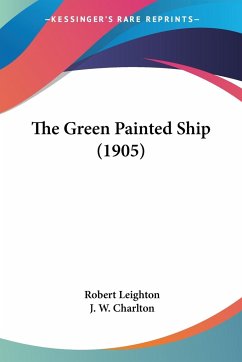- Broschiertes Buch
- Merkliste
- Auf die Merkliste
- Bewerten Bewerten
- Teilen
- Produkt teilen
- Produkterinnerung
- Produkterinnerung
Technical introduction to ship propeller hydrodynamics, for researchers in ocean technology, naval architecture, mechanical engineering.
Andere Kunden interessierten sich auch für
![The Union Of The Oceans By Ship Canal Without Locks Via The Atrato Valley (1859) The Union Of The Oceans By Ship Canal Without Locks Via The Atrato Valley (1859)]() Frederick M. KelleyThe Union Of The Oceans By Ship Canal Without Locks Via The Atrato Valley (1859)16,99 €
Frederick M. KelleyThe Union Of The Oceans By Ship Canal Without Locks Via The Atrato Valley (1859)16,99 €![The Green Painted Ship (1905) The Green Painted Ship (1905)]() Robert LeightonThe Green Painted Ship (1905)26,99 €
Robert LeightonThe Green Painted Ship (1905)26,99 €![The Phantom Ship The Phantom Ship]() Captain Frederick MarryatThe Phantom Ship27,99 €
Captain Frederick MarryatThe Phantom Ship27,99 €![Reports in Relation to the Affairs of the Harbour Commissioners of Montreal [microform]: and the Deepening of the Ship Channel in Lake St. Peter and t Reports in Relation to the Affairs of the Harbour Commissioners of Montreal [microform]: and the Deepening of the Ship Channel in Lake St. Peter and t]() Reports in Relation to the Affairs of the Harbour Commissioners of Montreal [microform]: and the Deepening of the Ship Channel in Lake St. Peter and t19,99 €
Reports in Relation to the Affairs of the Harbour Commissioners of Montreal [microform]: and the Deepening of the Ship Channel in Lake St. Peter and t19,99 €![Statics and Dynamics of the Ship Statics and Dynamics of the Ship]() Vladimir Semyonov-Tyan-ShanskyStatics and Dynamics of the Ship38,99 €
Vladimir Semyonov-Tyan-ShanskyStatics and Dynamics of the Ship38,99 €![Ship Sanitation and Hygiene Ship Sanitation and Hygiene]() Alexander Arnfinn OlsenShip Sanitation and Hygiene29,99 €
Alexander Arnfinn OlsenShip Sanitation and Hygiene29,99 €![Letter From Thomas Lack, Esq. and Report Thereon by the Special Committee of Ship Owners, April 30, 1827 [microform] Letter From Thomas Lack, Esq. and Report Thereon by the Special Committee of Ship Owners, April 30, 1827 [microform]]() Thomas LackLetter From Thomas Lack, Esq. and Report Thereon by the Special Committee of Ship Owners, April 30, 1827 [microform]15,99 €
Thomas LackLetter From Thomas Lack, Esq. and Report Thereon by the Special Committee of Ship Owners, April 30, 1827 [microform]15,99 €-
-
-
Technical introduction to ship propeller hydrodynamics, for researchers in ocean technology, naval architecture, mechanical engineering.
Hinweis: Dieser Artikel kann nur an eine deutsche Lieferadresse ausgeliefert werden.
Hinweis: Dieser Artikel kann nur an eine deutsche Lieferadresse ausgeliefert werden.
Produktdetails
- Produktdetails
- Verlag: Cambridge University Press
- Seitenzahl: 584
- Erscheinungstermin: 31. Juli 2003
- Englisch
- Abmessung: 229mm x 152mm x 34mm
- Gewicht: 936g
- ISBN-13: 9780521574709
- ISBN-10: 0521574706
- Artikelnr.: 22181691
- Herstellerkennzeichnung
- Libri GmbH
- Europaallee 1
- 36244 Bad Hersfeld
- gpsr@libri.de
- Verlag: Cambridge University Press
- Seitenzahl: 584
- Erscheinungstermin: 31. Juli 2003
- Englisch
- Abmessung: 229mm x 152mm x 34mm
- Gewicht: 936g
- ISBN-13: 9780521574709
- ISBN-10: 0521574706
- Artikelnr.: 22181691
- Herstellerkennzeichnung
- Libri GmbH
- Europaallee 1
- 36244 Bad Hersfeld
- gpsr@libri.de
Preface
Notation
Abbreviations
1. Brief review of basic hydrodynamic theory
2. Properties of distributions of singularities
3. Kinematic boundary conditions
4. Steady flows about thin, symmetrical sections in two-dimensions
5. Pressure distributions and lift on flat and cambered sections at small angles of attack
design of hydrofoil sections
7. Real fluid effects and comparisons of theoretically and experimentally determined characteristics
8. Cavitation
9. Actuator disk theory
10. Wing theory
11. Lifting-line representation of propellers
12. Propeller design via computer and practical considerations
13. Hull-wake characteristics
14. Pressure fields generated by blade loading and thickness in uniform flows
comparisons with measurements
15. Pressure fields generated by blade loadings in hull wakes
16. Vibratory forces on simple surfaces
17. Unsteady forces on two-dimensional sections and hydrofoils of finite span in gusts
18. Lifting-surface theory
19. Correlations of theories with measurements
20. Outline of theory of intermittently cavitating propellers
21. Forces on simple bodies generated by intermittent cavitation
22. Pressures on hulls of arbitrary shape generated by blade loading, thickness and intermittent cavitation
23. Propulsor configurations for increased efficiency
Appendices
Mathematical compendium
References
Index.
Notation
Abbreviations
1. Brief review of basic hydrodynamic theory
2. Properties of distributions of singularities
3. Kinematic boundary conditions
4. Steady flows about thin, symmetrical sections in two-dimensions
5. Pressure distributions and lift on flat and cambered sections at small angles of attack
design of hydrofoil sections
7. Real fluid effects and comparisons of theoretically and experimentally determined characteristics
8. Cavitation
9. Actuator disk theory
10. Wing theory
11. Lifting-line representation of propellers
12. Propeller design via computer and practical considerations
13. Hull-wake characteristics
14. Pressure fields generated by blade loading and thickness in uniform flows
comparisons with measurements
15. Pressure fields generated by blade loadings in hull wakes
16. Vibratory forces on simple surfaces
17. Unsteady forces on two-dimensional sections and hydrofoils of finite span in gusts
18. Lifting-surface theory
19. Correlations of theories with measurements
20. Outline of theory of intermittently cavitating propellers
21. Forces on simple bodies generated by intermittent cavitation
22. Pressures on hulls of arbitrary shape generated by blade loading, thickness and intermittent cavitation
23. Propulsor configurations for increased efficiency
Appendices
Mathematical compendium
References
Index.
Preface
Notation
Abbreviations
1. Brief review of basic hydrodynamic theory
2. Properties of distributions of singularities
3. Kinematic boundary conditions
4. Steady flows about thin, symmetrical sections in two-dimensions
5. Pressure distributions and lift on flat and cambered sections at small angles of attack
design of hydrofoil sections
7. Real fluid effects and comparisons of theoretically and experimentally determined characteristics
8. Cavitation
9. Actuator disk theory
10. Wing theory
11. Lifting-line representation of propellers
12. Propeller design via computer and practical considerations
13. Hull-wake characteristics
14. Pressure fields generated by blade loading and thickness in uniform flows
comparisons with measurements
15. Pressure fields generated by blade loadings in hull wakes
16. Vibratory forces on simple surfaces
17. Unsteady forces on two-dimensional sections and hydrofoils of finite span in gusts
18. Lifting-surface theory
19. Correlations of theories with measurements
20. Outline of theory of intermittently cavitating propellers
21. Forces on simple bodies generated by intermittent cavitation
22. Pressures on hulls of arbitrary shape generated by blade loading, thickness and intermittent cavitation
23. Propulsor configurations for increased efficiency
Appendices
Mathematical compendium
References
Index.
Notation
Abbreviations
1. Brief review of basic hydrodynamic theory
2. Properties of distributions of singularities
3. Kinematic boundary conditions
4. Steady flows about thin, symmetrical sections in two-dimensions
5. Pressure distributions and lift on flat and cambered sections at small angles of attack
design of hydrofoil sections
7. Real fluid effects and comparisons of theoretically and experimentally determined characteristics
8. Cavitation
9. Actuator disk theory
10. Wing theory
11. Lifting-line representation of propellers
12. Propeller design via computer and practical considerations
13. Hull-wake characteristics
14. Pressure fields generated by blade loading and thickness in uniform flows
comparisons with measurements
15. Pressure fields generated by blade loadings in hull wakes
16. Vibratory forces on simple surfaces
17. Unsteady forces on two-dimensional sections and hydrofoils of finite span in gusts
18. Lifting-surface theory
19. Correlations of theories with measurements
20. Outline of theory of intermittently cavitating propellers
21. Forces on simple bodies generated by intermittent cavitation
22. Pressures on hulls of arbitrary shape generated by blade loading, thickness and intermittent cavitation
23. Propulsor configurations for increased efficiency
Appendices
Mathematical compendium
References
Index.





![Reports in Relation to the Affairs of the Harbour Commissioners of Montreal [microform]: and the Deepening of the Ship Channel in Lake St. Peter and t Reports in Relation to the Affairs of the Harbour Commissioners of Montreal [microform]: and the Deepening of the Ship Channel in Lake St. Peter and t](https://bilder.buecher.de/produkte/66/66185/66185441m.jpg)


![Letter From Thomas Lack, Esq. and Report Thereon by the Special Committee of Ship Owners, April 30, 1827 [microform] Letter From Thomas Lack, Esq. and Report Thereon by the Special Committee of Ship Owners, April 30, 1827 [microform]](https://bilder.buecher.de/produkte/66/66146/66146141m.jpg)